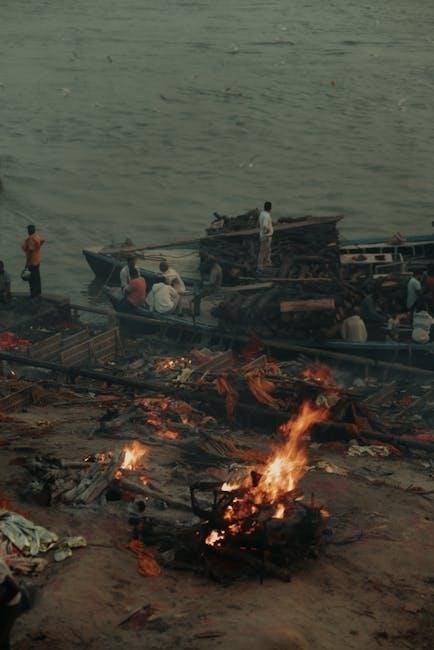Richard Flanagan’s debut novel, Death of a River Guide (1994), follows Aljaz Cosini’s near-death experience on Tasmania’s Franklin River, exploring life, death, and redemption through haunting flashbacks.
1.1 Overview of the Novel
Death of a River Guide, Richard Flanagan’s debut novel, published in 1994, tells the story of Aljaz Cosini, a river guide trapped beneath a waterfall on Tasmania’s Franklin River. As he drowns, Aljaz experiences a series of flashbacks that reveal his life, family, and the tragic events that shaped him. The novel explores themes of life, death, and redemption, blending personal and collective histories. Flanagan’s vivid prose captures the beauty and danger of the Franklin River, which serves as a central symbol of transformation and fate. The book was shortlisted for the Miles Franklin Award, establishing Flanagan as a major literary talent. It remains a powerful exploration of human struggle and the interconnectedness of past and present.
1.2 Background of Richard Flanagan
Richard Flanagan is an Australian author born in Tasmania, known for his lyrical prose and deep connection to his native landscape. Before becoming a writer, he studied law and worked as a river guide, experiences that influenced his debut novel, Death of a River Guide. His father’s imprisonment during World War II also shaped his writing, particularly in later works like The Narrow Road to the Deep North, which won the Man Booker Prize in 2014. Flanagan’s writing often explores themes of identity, history, and the Tasmanian wilderness. His unique storytelling has earned him a reputation as one of Australia’s most celebrated literary voices.

Plot Structure and Narrative Style
Richard Flanagan’s Death of a River Guide features a non-linear narrative, with flashbacks detailing Aljaz Cosini’s life as he drowns, blending personal and emotional themes seamlessly.
2.1 Non-Linear Narrative and Flashbacks
Richard Flanagan’s Death of a River Guide employs a non-linear narrative, blending the present moment of Aljaz Cosini’s drowning with vivid flashbacks of his life. As Aljaz lies trapped beneath the Franklin River’s waterfall, his memories unfold in a fluid, unchronological sequence, revealing his personal struggles, family history, and existential reflections. These flashbacks not only provide depth to his character but also explore broader themes of identity, mortality, and redemption. The interplay between the present tense of his drowning and the past creates a gripping, introspective atmosphere, drawing readers into Aljaz’s emotional and psychological journey. This narrative structure underscores the novel’s exploration of human complexity and the interconnectedness of life’s experiences.
2.2 The Drowning of Aljaz Cosini
Aljaz Cosini’s drowning in the Franklin River serves as the novel’s emotional and narrative climax. Trapped beneath a waterfall, Aljaz faces his mortality, triggering a cascade of memories and visions. His final act of heroism—sacrificing himself to save a tourist—underscores his complex character, revealing a depth of courage and selflessness. The drowning scene is intricately woven with themes of life, death, and redemption, symbolizing Aljaz’s ultimate reconciliation with his past. Flanagan’s vivid depiction of this moment immerses readers in Aljaz’s desperation and transformation, making it a hauntingly powerful conclusion to his journey.

Main Characters and Their Roles
Richard Flanagan’s Death of a River Guide revolves around Aljaz Cosini, a Tasmanian river guide grappling with personal regrets and family legacies. His complex journey explores themes of identity, guilt, and redemption, while other characters like his family members and tourists add depth to the narrative, highlighting the interconnectedness of human experiences.
3.1 Aljaz Cosini: The Protagonist
Aljaz Cosini, the protagonist of Death of a River Guide, is a Tasmanian river guide whose near-death experience triggers a series of flashbacks. As he lies drowning under a waterfall on the Franklin River, Aljaz reflects on his life, revealing a man burdened by regret and a complex relationship with his family’s past; His role as a guide symbolizes his attempt to navigate not just the river but also his internal struggles. Through his journey, Flanagan portrays Aljaz as an ordinary man confronting extraordinary circumstances, offering a deeply human exploration of identity, guilt, and the search for redemption.
3.2 The Cosini Family and Their Legacy
The Cosini family plays a central role in shaping Aljaz’s identity and struggles in Death of a River Guide. Through Aljaz’s visions, Flanagan reveals a lineage marked by both resilience and tragedy, deeply rooted in Tasmania’s wilderness. The family’s history, intertwined with the Franklin River, reflects their connection to the land and their struggles against it. Aljaz’s memories of his ancestors and their hardships underscore the weight of legacy he carries. His father’s stories and the family’s past misfortunes haunt him, influencing his decisions and sense of self. The Cosini legacy is one of survival, regret, and a profound bond with the natural world, which Aljaz grapples with as he confronts his own mortality.

Themes and Motifs in the Novel
The novel explores themes of guilt, memory, and the supernatural, weaving them into a narrative that reflects the interconnectedness of human experiences and the power of nature.
4.1 The Struggle Between Life and Death
In Death of a River Guide, the struggle between life and death is central, as Aljaz Cosini’s near-drowning experience triggers a series of flashbacks. These memories reveal his inner turmoil and regrets, reflecting a broader human confrontation with mortality. The Franklin River serves as a symbol of both life-giving force and deadly power, mirroring Aljaz’s existential journey. Through his desperate fight to survive, Flanagan explores themes of sacrifice and redemption, highlighting how life’s fragility can lead to profound introspection and self-discovery. The novel ultimately portrays death not as an end, but as a catalyst for understanding life’s true meaning.
4;2 Nature and Humanity: The Franklin River
The Franklin River in Death of a River Guide is not just a setting but a living entity that shapes the lives of its characters. It embodies the dual forces of nature—both nurturing and destructive. The river’s wild beauty and power symbolize humanity’s connection to the natural world, while its unpredictability reflects the fragility of human existence. Flanagan uses the river to explore themes of survival, identity, and the clash between modernity and wilderness. The Franklin River’s role in Tasmanian history and culture adds depth to the narrative, highlighting the struggle between human ambition and environmental preservation. Through Aljaz’s journey, the river becomes a mirror of humanity’s complex relationship with nature.

4.3 Personal and Collective Redemption
In Death of a River Guide, personal and collective redemption are central themes, intertwined with the protagonist’s near-death experience. Aljaz Cosini’s drowning forces him to confront his past, revealing a life marked by regret and missed opportunities. Through his flashbacks, Flanagan explores the idea of personal redemption, as Aljaz seeks forgiveness and closure. Simultaneously, the novel addresses collective redemption, reflecting on Tasmania’s history and the clash between nature and human ambition. The Franklin River, as a symbol of both destruction and renewal, embodies the possibility of redemption for individuals and society alike. Flanagan’s narrative suggests that redemption is not just an individual journey but also a collective one, tied to healing and reconciliation.

The Franklin River: A Central Symbol
The Franklin River is a central symbol in Richard Flanagan’s Death of a River Guide, representing life, death, and transformation. Its power shapes the plot and themes.
The Franklin River in Richard Flanagan’s Death of a River Guide is a potent symbol of life and death. Its turbulent waters mirror Aljaz Cosini’s internal struggles, as the river’s force both sustains and threatens existence. The river’s depths, where Aljaz drowns, symbolize the unknown, while its surface reflects the beauty and brutality of nature. This duality underscores the novel’s exploration of human fragility and the inevitability of death. The river’s role in Aljaz’s near-death experience serves as a metaphor for the cyclical nature of life, where endings and beginnings intertwine, offering a profound meditation on existence. The Franklin River is central to the plot of Death of a River Guide, serving as both the setting and a catalyst for Aljaz Cosini’s journey. The river’s treacherous rapids and sudden flooding create the crisis that drives the narrative, forcing Aljaz to confront his past. As he drowns, the river’s power triggers his visions, revealing his life’s regrets and the legacy of his family. The river’s fury mirrors Aljaz’s internal turmoil, while its beauty underscores the fragility of human existence. Through the river’s role, Flanagan weaves together action, introspection, and symbolism, creating a compelling exploration of life, death, and redemption. The river’s presence is not just a backdrop but an active force shaping the story’s emotional and psychological depth. Set against Tasmania’s rugged wilderness, Death of a River Guide reflects the island’s rich cultural heritage, the Franklin River’s historical environmental battles, and its cultural and literary resonance within Australian identity. Tasmania’s wilderness, particularly the Franklin River, holds profound cultural and environmental significance. In Death of a River Guide, Richard Flanagan captures the raw beauty and spiritual essence of this region. The Franklin River, a UNESCO World Heritage Site, symbolizes the clash between nature and human endeavors. Flanagan’s portrayal of the river as both a life-giving and destructive force mirrors Tasmania’s historical struggles, including the famous Franklin Dam protests of the 1980s, which sought to preserve the region’s pristine wilderness. Through Aljaz Cosini’s journey, the novel underscores the importance of Tasmania’s untamed landscapes in shaping its identity and the human experience. Richard Flanagan’s Death of a River Guide holds a significant place in Australian literature, marking the debut of a writer whose work has resonated deeply with readers and critics alike. The novel’s exploration of personal and collective identity, intertwined with Tasmania’s wilderness, reflects broader Australian themes of nature, history, and redemption. Widely regarded as a classic, it has been shortlisted for major literary awards, including the Miles Franklin Literary Award. Flanagan’s unique voice and storytelling have cemented his reputation, with Death of a River Guide standing as a foundational work in his oeuvre, contributing to his acclaim as one of Australia’s most celebrated authors. Death of a River Guide received widespread critical acclaim and commercial success, solidifying Richard Flanagan’s reputation as a prominent Australian author. Richard Flanagan’s Death of a River Guide received significant critical acclaim upon its release in 1994. The novel was shortlisted for the prestigious Miles Franklin Literary Award, a testament to its literary merit. Critics praised its vivid prose, emotional depth, and exploration of universal themes such as life, death, and redemption. The book solidified Flanagan’s reputation as a rising talent in Australian literature. Its success also drew attention to Tasmania’s wilderness and the Franklin River’s cultural significance. The novel’s acclaim marked the beginning of Flanagan’s celebrated career, leading to future works like The Narrow Road to the Deep North, which later won the Booker Prize. Death of a River Guide achieved notable commercial success and resonated deeply with readers. The novel became a bestseller in Australia and attracted international attention, solidifying its place in contemporary literature. Readers were captivated by Flanagan’s vivid storytelling and the emotional depth of Aljaz Cosini’s journey. The book’s exploration of universal themes like life, death, and redemption struck a chord with audiences. Many praised the novel for its raw, immersive portrayal of Tasmania’s wilderness and the Franklin River’s haunting beauty. The novel’s success helped establish Flanagan as a major literary voice, with readers and critics alike celebrating its originality and emotional impact. Its enduring popularity continues to draw new readers to Flanagan’s work. Richard Flanagan’s prose in Death of a River Guide is lyrical and immersive, blending magical realism with vivid imagery to create a deeply emotional and haunting narrative. Richard Flanagan’s prose in Death of a River Guide is both lyrical and evocative, crafting a narrative that immerses readers in the haunting world of Aljaz Cosini. His storytelling seamlessly blends the surreal with the real, creating a vivid tapestry of memories, emotions, and landscapes. Flanagan’s use of language is precise yet poetic, capturing the essence of Tasmania’s wilderness and the inner turmoil of his protagonist. The non-linear structure of the novel, intertwined with flashbacks, reflects Flanagan’s mastery of narrative complexity. His ability to balance introspection with action ensures a deeply engaging and emotionally resonant reading experience, showcasing his skill as a storyteller and his unique voice in Australian literature. Richard Flanagan employs magical realism in Death of a River Guide to create a captivating narrative that blends the surreal with the real. As Aljaz Cosini drowns, his visions of the past and present intertwine, offering a profound exploration of his inner world. These haunting yet vivid sequences serve as a bridge between reality and the supernatural, allowing Flanagan to delve into themes of life, death, and redemption. The magical elements enhance the emotional depth of the story, making the protagonist’s journey both intimate and universal. Flanagan’s use of this literary device underscores his ability to craft a story that resonates on multiple levels, inviting readers to reflect on the human condition. Richard Flanagan’s ‘Death of a River Guide’ is a powerful exploration of life, death, and redemption, capturing the essence of human struggle through Aljaz Cosini’s poignant journey, leaving a lasting emotional and philosophical impact. Richard Flanagan’s Death of a River Guide holds profound significance as a debut novel that catapulted him into literary prominence. The story’s exploration of life, death, and redemption resonates deeply, capturing the essence of human struggle and existential reflection. Its vivid portrayal of Tasmania’s Franklin River as a symbol of both beauty and danger underscores themes of environmentalism and cultural identity. The novel’s non-linear narrative and emotional depth have left a lasting impact on Australian literature, solidifying Flanagan’s reputation as a masterful storyteller. Its ability to blend personal and collective experiences makes it a timeless tale of introspection and connection to the natural world. Richard Flanagan’s Death of a River Guide marked the beginning of a distinguished literary career, establishing him as a powerful voice in Australian literature. This debut novel showcased his ability to weave personal narratives with broader cultural and environmental themes, resonating with readers worldwide. Flanagan’s subsequent works, such as The Narrow Road to the Deep North, further cemented his reputation as a masterful storyteller. His lyrical prose and emotional depth have earned him critical acclaim, including the Man Booker Prize. Through his writing, Flanagan continues to explore themes of identity, humanity, and the natural world, leaving a lasting legacy in contemporary literature.5.1 The River as a Symbol of Life and Death

5.2 The River’s Role in the Plot

Historical and Cultural Context
6.1 Tasmania’s Wilderness and Its Significance
6.2 The Novel’s Place in Australian Literature

Reception and Impact of the Novel
7.1 Critical Acclaim and Awards
7.2 Commercial Success and Readers’ Response

Writing Style and Literary Devices
8.1 Flanagan’s Prose and Storytelling
8.2 Use of Magical Realism
9.1 The Significance of ‘Death of a River Guide’
9.2 Richard Flanagan’s Legacy